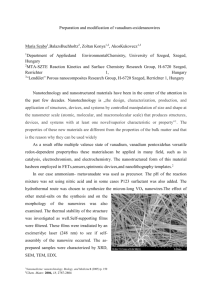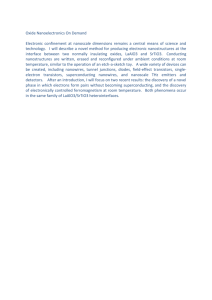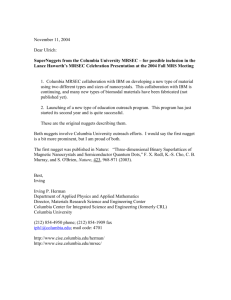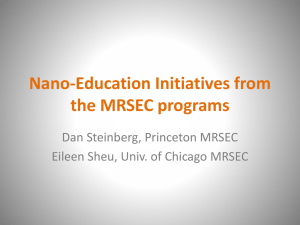Annual Report - Nuggets - Materials Research Science and
advertisement
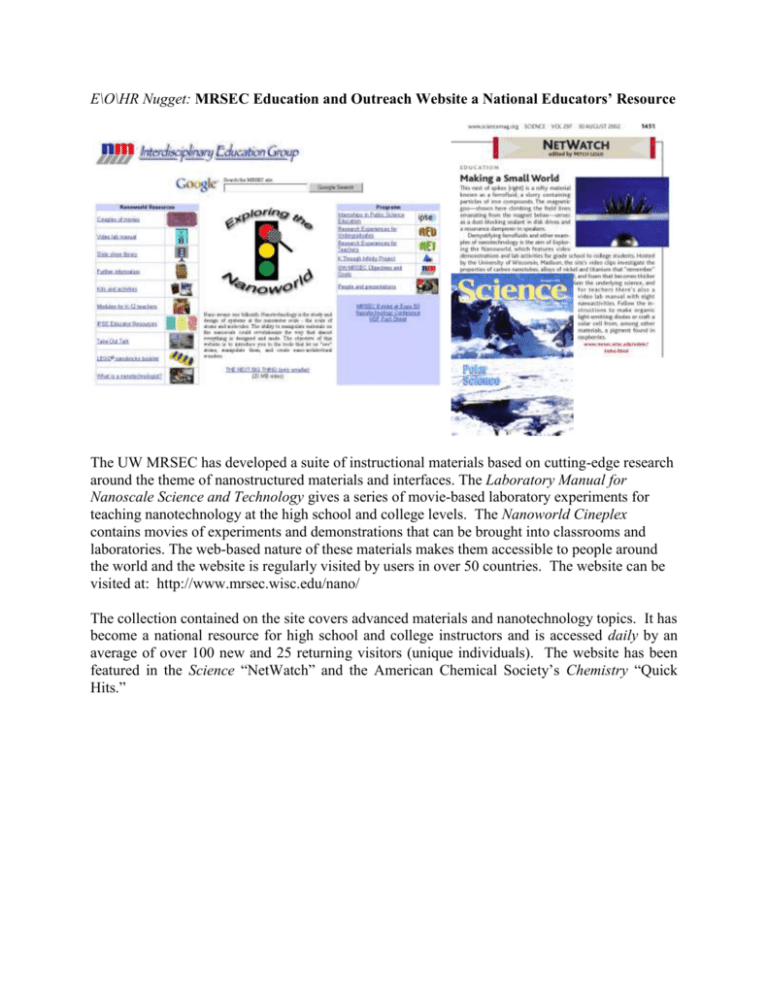
E\O\HR Nugget: MRSEC Education and Outreach Website a National Educators’ Resource The UW MRSEC has developed a suite of instructional materials based on cutting-edge research around the theme of nanostructured materials and interfaces. The Laboratory Manual for Nanoscale Science and Technology gives a series of movie-based laboratory experiments for teaching nanotechnology at the high school and college levels. The Nanoworld Cineplex contains movies of experiments and demonstrations that can be brought into classrooms and laboratories. The web-based nature of these materials makes them accessible to people around the world and the website is regularly visited by users in over 50 countries. The website can be visited at: http://www.mrsec.wisc.edu/nano/ The collection contained on the site covers advanced materials and nanotechnology topics. It has become a national resource for high school and college instructors and is accessed daily by an average of over 100 new and 25 returning visitors (unique individuals). The website has been featured in the Science “NetWatch” and the American Chemical Society’s Chemistry “Quick Hits.” IEG Partnership Nugget: The UW-MRSEC Continues Its Partnership with the Discovery World Museum in Milwaukee, WI The collaboration between the University of Wisconsin-Madison MRSEC and Discovery World Museum (DW) continues to break new ground. The two organizations have established a solid foundation for collaborative work through their NSF grants funded through the Internships in Public Science Education (IPSE) program. IPSE is an intern-focused NSF-funded program that trains graduate and undergraduate students from education, science, and engineering-related disciplines to create hands-on, interactive activities that use basic science concepts to explain cutting-edge nanotechnology concepts and applications. The urban Milwaukee museum provides expertise in public science education, access to local science teachers, and opportunities to test materials with a live audience. The UW MRSEC offers research facilities and technical expertise on nanotechnology research and nanotechnology education. The strengths of each partner are thus leveraged to bring cutting-edge science to the public and to provide valuable professional development experiences for all involved. Examples of collaboration include exhibit development under the moniker “Dream Big Think Small” and summer nanotechnology camps around the theme of “Dream Big Think Small Build-It Camp”. Details of the IPSE outcomes and curriculum materials created can be found at: http://www.mrsec.wisc.edu/edetc/IPSE/index.html IEG Education Nugget: New Laboratory on Synthesis and Magnetic Manipulation of Nickel Nanowires Is Added to the Laboratory Manual for Nanoscale Science and Technology Several new experiments have been added to the video-based Laboratory Manual for Nanoscale Science and Technology, including a lab developed by Anne Bentley, an NSF Graduate Fellow, and personnel from the University of Wisconsin-Madison MRSEC Interdisciplinary Education Group. In this experiment, students prepare and analyze nickel nanowires using a template synthesis technique commonly found in the scientific literature. Electrodeposition of nickel to fill the nanopores pores of a commercially available alumina filtration membrane is accomplished using a nickel salt solution and a AA battery. The nanowires (which are 200 nm in diameter and up to 50 m long) can be liberated from the membrane by dissolving both the silver cathode and the alumina template. Suspensions of nanowires can be dispersed on a microscope slide and observed using an optical microscope with a 10X or 50X lens. The alignment and movement of the magnetic nanowires can be controlled using common magnets. This experiment is appropriate in the general chemistry curriculum and gives students a hands-on experience in nanotechnology. High school and college students can learn about nanotechnology and how nanoscale materials are made using this experiment, which requires only a modest investment in time and budget. The nanowire synthesis lab uses a simple electrochemical method to make nickel nanowires and common optical microscopy to analyze their behavior in a magnetic field. Field-testing of this lab has occurred in a variety of courses ranging from introductory chemistry and materials science courses to a graduate level physics course and several institutions including Beloit College, Milwaukee School of Engineering, and the University of Wisconsin – Madison. Most students reported they had never heard of nanotechnology before the lab, and they liked the fact that it was relevant to current research and emerging technologies. The vast majority of student teams were able to successfully create and manipulate nanowires. The paper on “Template Synthesis and Magnetic Manipulation of Nickel Nanowires” written by Anne Bentley and her collaborators will appear in the Journal of Chemical Education.


